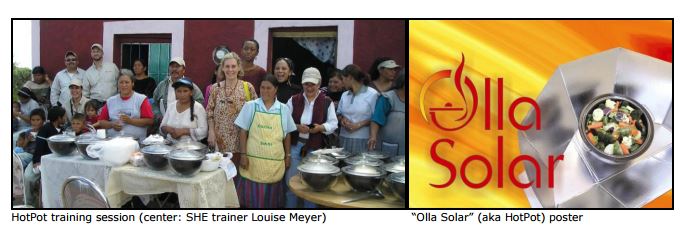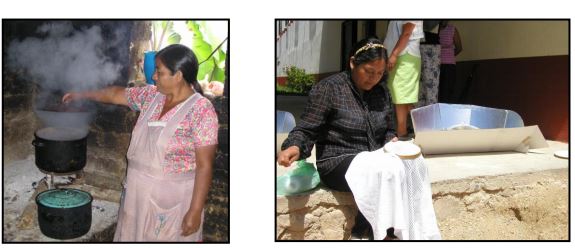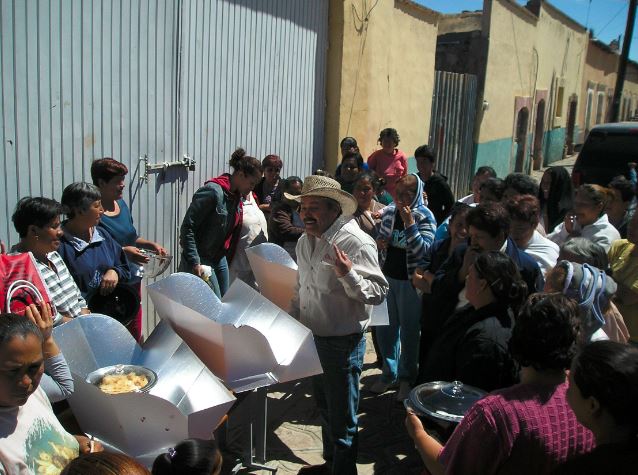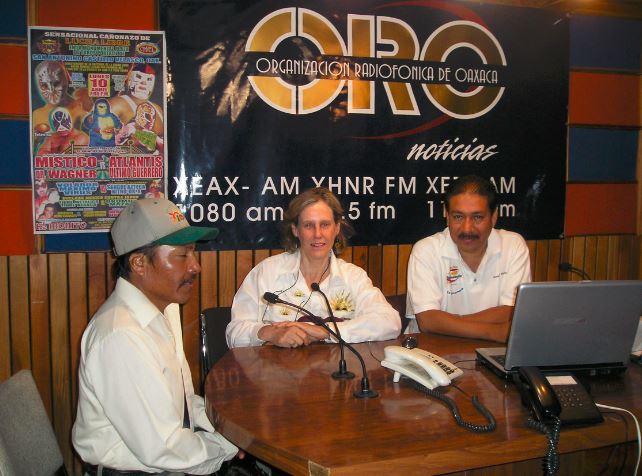
The HotPot Initiative in Mexico

Since 2003, SHE has been conducting solar cooking projects in rural Mexico, and this work continues today. This article describes the history of our efforts — with local partners — to introduce solar cookers and provide training and project evaluations.
In 2004, about 26 million people in Mexico (25% of the total population) lived in rural areas, with 13 million of these below the poverty line. Over 1% of the forest cover was being destroyed annually, with 20 million tons of firewood burnt each year for cooking and heating.
HotPot prototype pilot project in Sierra Gorda Biosphere Reserve – In May of 2003, Solar Household Energy (SHE) partnered with “El Fondo Mexicano para la Conservacion de la Naturaleza” (FMCN) to run a pilot test for a HotPot solar cooker prototype at the Sierra Gorda Biosphere Reserve in Mexico, managed by Grupo Ecologico Sierra Gorda (GESG). Over three weeks, SHE introduced thirty HotPot panel solar cookers in the communities of Purisima (pop. 4,000) and Mavi (62 homes). FMCN donated thirty HotPots to the community, and SHE cofounder and trainer Louise Meyer carried out extensive training and field testing to confirm the HotPot’s utility and its cultural acceptance, training two local women to become solar cooking instructors. Meyer also organized the infrastructure necessary to sustain large-scale introduction and evaluation of results.
HotPot Solar Cooker Research and Development – SHE used feedback from this field testing and from 24 solar cooking experts around the world, as well as extensive research and testing by the Florida Solar Energy Center, to hone the HotPot into the durable, efficient, easy-to-use, portable and commercially viable solar cooker that it is today.
Mass production of the HotPot in Mexico – Later that year, SHE was awarded funds by the World Bank through its highly competitive annual Development Marketplace program to disseminate the HotPot in rural Mexico. SHE believes the long-term success of solar cooking can only be guaranteed by market-oriented solutions, and thus partnered with Mexican for-profit corporation, Energía PortatilS.A. (EPSA), to operate mass manufacturing, marketing and distribution of the HotPot. With support from the Alcoa Foundation, SHE achieved a detailed marketing study and business plan for the Mexican and U.S. markets, and designed a reflector based on aluminum sheet foldable panels for the higher-end market, with FMCN acting as coordinator and investor. Agreements were secured with industries to assure sustainability of HotPot production, setting the optimum HotPot price at around $35, allowing users to recoup their investment in less than a year from fuel savings, given the HotPot lifetime of over 10 years. SHE assisted with training, coordination and international communication and promotion activities through its participation in a permanent advisory committee to the project.
HotPot dissemination in rural Mexico – By July 2004, 2,000 HotPots had been manufactured and trucked to eight Mexican conservation NGOs. Training materials (user’s guide, recipe book, film, banners, posters, flyers) were designed and produced. Three SHE trainers spent ten weeks in-country, organizing programs in the states of Queretaro, Oaxaca, Nuevo Leon, and Coahuila, and conducting training by the cascade method. The trainers returned in 2005 to spend eight weeks in the states of San Luis Potosi, Chihuahua, and Moreila, and to revisit the original programs. Four regional coordinators and eight retailers were hired and committed to the project for three years.

Indoor Air Pollution study in rural Mexico – In conjunction with the World Bank development grant, in 2004 SHE received a grant from the US Environmental Protection Agency (USEPA), Partnership for Clean Indoor Air (PCIA) program to assess the health effects of the partial substitution of biomass cooking with solar cooking techniques; the most effective techniques to introduce solar cooking in rural Mexico; and the sustainability of solar cooking practices based upon demographic variables in the states of Coahuila, Queretaro, Oaxaca. Research was divided into three stages: wood consumption during the rainy season, during the dry season, and operation of the solar cooker. Each stage of the study involved 20 families. All study participants reported increased savings in income and improved air quality from using HotPots. The fuelwood consumption research also set a precedent for comparing cooking technologies using different fuels. Between 2004 and 2006, SHE distributed 1738 HotPots to almost 4,000 people. Additionally, media coverage via radio and television programs on solar cooking in Monterrey and Oaxaca reached tens of thousands of viewers.
Ongoing HotPot initiative project support – SHE has continued its work in Mexico with site visits and over 100 public demonstrations of solar cooking. In 2006, Louise Meyer traveled to Zacatecas to advise Zacatecas University on distributing and promoting HotPots in rural areas where women suffer from respiratory illnesses because of cooking from fuel wood. In recent years, SHE has worked in partnership with Olla Solar to consult associations on how to supply solar cookers to impoverished communities. In 2008, SHE led integrated cooking workshops on behalf of Rotary Tlanapantla. These workshops in Tlautla included a combination of daily demonstrations to about 1000 people on usage and maintenance of solar cookers. SHE has also worked with members of Torreon Women’s Rotary in Oaxaca by offering technical support on field visits and advising community leaders on HotPot installation and solar cooking promotion strategies. Ten years later, since the start of the Hot Pot Initiative in Mexico, thanks to continued collaboration with EPSA, FMCN, and with support from various funders,over 30,000 HotPots have been sold worldwide, including over 20,000 in Mexico.





